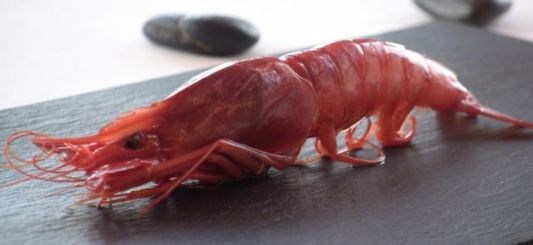Not all prawns were born equal and the most prized of them all is found in Dénia. This beautiful coastal town of the Valencian Community, is located in a bay at the foot of the mountain range Montgó. In the very centre of the bay there is, surrounded by palms, the harbour of Dénia. Despite its importance it has conserved the ambience of a typical Mediterranean fishing port. From here you can take ferries to the Balearic Islands of Majorca and Menorca, which can be reached in about three and a half hours. Near the port there is an area called "Baix la Mar" with traditional fishermen houses and picturesque squares and alleys. Here you can enjoy Dénia’s excellent seafood and amongst all that is on offer is the most famous prawn in Spain, the ‘Striped Red Prawn of Dénia (Gamba Roja/Rayada de Dénia). A unique crustacean found off the coast of this traditional fishing town and considered an international delicacy.
The Red Prawn from Dénia has an intense flavour due to its unusually high concentration of iodine and salt mixed with its lean meat and has become a staple ingredient for chefs in the region and is now gaining international recognition. Unfortunately this shrimp is not easy to catch so it’s not cheap as numbers caught on a daily basis are very low making it one of the most exclusive foods in the Valencian Community but on a special occasion it is a real treat. This spectacular shrimp is also easily identifiable from a anatomical point of view, it has a strong red pigmentation different to the common white prawn with red stripes along its tail, while at the same time it has a much larger head which hides an exquisite explosion of flavours. The characteristics of the Red Prawn from Dénia have made it the signature dish of many famous restaurants both within Dénia and the rest of the Community.
.jpg)
One of the restaurants, which prides itself on dishes made with the Dénia Red Prawn, is the Quique Dacosta Restaurant, which has led to this seafood acquiring an international reputation. In the menu "Local Universe", Dacosta has created three different dishes with the Dénia Red Prawn: a plate of crispy crust Dénia Red Prawn served as a snack, a bowl of Dénia Red Prawn slightly cooked in sea water and finally a dish made with the juice from the head of the prawn inside a floating sphere. However this is very fancy cooking and the majority of chefs in the region say that the best way to cook the Dénia Red Prawn is simply boiling it in seawater rather than cooking it on the hot plate as you would with most other crustaceans. Apparently the seawater prevents their juices from being released and all the flavour is kept inside. For a large prawn, it should be in boiling water for approximately three minutes then taken out immediately and with a lot of care so it doesn’t break, placed immediately in ice-cold seawater to reduce its temperature. The ideal serving temperature is 15ºC. Which ever way you prepare it they all agree it should be served without any dressing, sauces or garnishes as these would only mask the natural flavour of this very special prawn.

The areas where you can fish Dénia Red Prawns are very limited and are found in the Mediterranean Sea between the Cape of San Antonio and Ibiza. There is actually a rather unique marine trench in the seabed where the highest concentration of Dénia Red Prawns can be found. However this shady habitat is over 600m deep so virtually no sunlight ever reaches it and as a result the shrimps main food source is algae that grow at these depth and as the algae can’t photosynthesise they are a much finer food source than those found at shallower depths. Additionally the sea current follows the trench bringing fresh water through it permanently and as there are practically no predators in the trench, it allows the shrimps to grow to a large size and obtain a good weight.
Without doubt, the best place to buy Dénia Red Prawns is the Lonja at Dénia port. Every day there is a traditional auction where local restauranteurs and the general public bid on lots of seafood and fish arriving in on the fishing boats. However if you are not up for an auction,'the temple' of the red prawn in the city is definitely the restaurant El Faralló found in the area of Dénia known as Las Rotas. Originally the restaurant was just a bar that drew customers from a nearby campground. Nowadays The Faralló has managed to become one of the gastronomic temples of Dénia and one of the most highly recommended restaurants to taste the Dénia Red rawn, a fantastic place to celebrate a special occasion.
Dénia was recently recognised by UNESCO (the United Nation cultural organisation) as the town of origin for this special prawn launching it to international fame. So if you have never tried them and happen to be passing through Dénia, they are an absolute "must" to have on the agenda for any food lover.
Ver mapa más grande